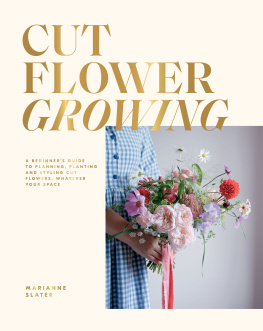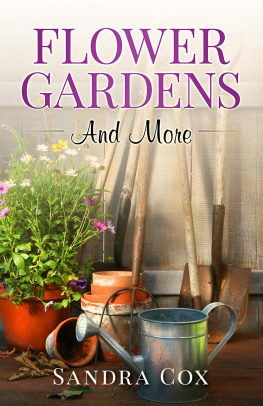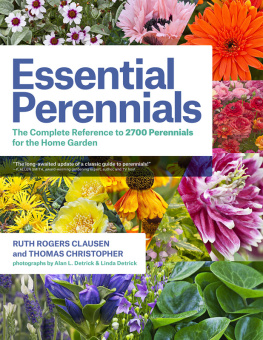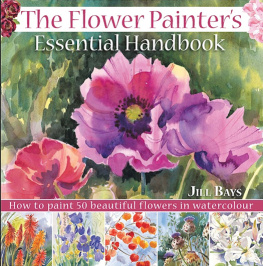Perennials
Short and Tall

Perennials
Short and Tall
A Seasonal Progression of
Flowers for Your
Garden

Bleeding Heart
Dicentra spectabilis
Moya L. Andrews
Illustrated by Gillian Harris

This book is a publication of
Indiana University Press
601 North Morton Street
Bloomington, IN
47404-3797 USA
http://iupress.indiana.edu
Telephone orders 800-842-6796
Fax orders 812-855-7931
Orders by e-mail
2008 by Moya L. Andrews and Gillian Harris
All rights reserved
No part of this book may be reproduced or utilized in any
form or by any means, electronic or mechanical, including
photocopying and recording, or by any information storage
and retrieval system, without permission in writing from the
publisher. The Association of American University Presses
Resolution on Permissions constitutes the only exception
to this prohibition.
The paper used in this publication meets the minimum
requirements of American National Standard for
Information SciencesPermanence of Paper for
Printed Library Materials, ANSI Z39.48-1984.
Manufactured in China
See for Library of Congress
Cataloging-in-Publication data.
1 2 3 4 5 13 12 11 10 09 08
A NOTE ABOUT ZONES...
Although this book often refers to the Midwest
garden, the perennials profiled thrive in many
of North Americas hardiness zones.
Please see the USDA Plant Hardiness Zone Map
on to determine which zone is yours.
The headnote for each plant specifies the
zones in which it can be cultivated.

THE FRAGRANCE
OF FLOWERS
STAYS IN THE HANDS
OF THOSE
WHO GIVE THEM.
Chinese proverb
Contents

Columbine, Aquilegia canadensis
(red and yellow) and
Aquilegia chrysantha
(yellow)
Illustrations

Lavender
Lavandula angustifolia
Preface
What a desolate place would be
a world without flowers!
It would be a face without a smile,
a feast without a welcome.
Clara Balfour
These words resonate with all who love flowers. Flowers are not a luxury for us, they are a necessity, and they provide a kind of anticipatory structure in our lives. We look forward to the appearance of the varied types of flowers in our gardens, and treasure their arrival in the same way we treasure the reappearance of dear friends. Each winter we await the early spring flowers with excitement that is palpable. Knowing the impermanence of each individual flower does not daunt us. It just makes us savor their special time with us, as we gaze at them hoping to imprint them in our memory.
We know that perennial flowers recur in the predictable cycle of the seasons. And so it is that across the entire growing season we enjoy the succession of bloom, secure in the knowledge of the unfolding sequence. Our dream is that at all times during the growing season, we will be able to step out into our gardens and find flowers to pick. We collect containers to suit the demands of all sizes and types of flowers and we imagine just how they will look, and where we will place our bouquets in our homes. When winter weather robs us of the instant gratification of flowers from our own gardens, we look forward to having outdoor flowers again, and prepare houseplants that bloom indoors. We purchase flowers for Thanksgiving, for the holidays, and for Valentines Day. Every seasonal event is an opportunity for the flower lover. Seasons and events have heightened meaning for us because of the flowers associated with them.
This book is about the integral part flowers play in our lives and their meaning, not only in our age, but in ages past. Each family of flowers has its own history and peculiarities, just as human families do. Flowering plants pedigrees and stories are fascinating, and knowing about them increases the depth of the relationship each of us has with our own plants. Time is inextricably woven into the fabric of gardening as the destiny of all flowers is anchored in the seasons. And since the seasons occur at different times dependent on hemispheres, there are always flowers blooming somewhere in the world.
As already noted, flowers are the focus of this book and we will discuss perennial plants that flourish in areas with cold winters, where their roots must withstand sub-freezing temperatures. We will describe perennial flower gardening with special attention to zones 4 through 7 on the USDA Hardiness Zone Map. Of course, since a perennial is by definition a plant that survives for at least three years, the term has different connotations in different areas of the United States. Plants that live for only one growing season in areas with cold winters, for example, may be perennial in regions with winter temperatures that stay above freezing.
Perennial plants form an eclectic group. Some are tall and others are short, and their heights, in addition to their other distinctive features, add variety to gardens. We will take their habits as well as their requirements into account and provide advice on how and where to plant them so they settle in, thrive, and provide a progression of bloom.
We have also profiled twenty-five of the best perennials that grow in the Midwest and perform reliably for both experienced and novice gardeners. These are described and illustrated in . You will learn about where these stalwart plants come from and how to make them feel at home in your own garden. The book closes with twenty-two appendices. Here you will find lists of drought-tolerant plants, plants with grey foliage, flowers to plant in the fall, tall and short plants, flowers that bloom in the shade, blue and pink and orange flowers, tips on choosing the best site, and more.
Perennials
Short and Tall

Forget-me-not, Brunnera macrophylla

Peony Paeonia lactiflora
ONE
An Inviting Garden
Wont you come into my garden?
I want my roses to see you.
Richard Sheridan
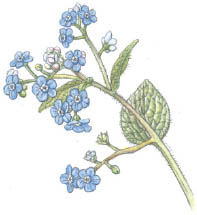
Those of us who love flowers, to an extent that other people might find hard to understand, have an intimate relationship with them. This relationship deepens as we ourselves mature and learn more about their distinctive features and how they impact us. We may start out responding to their colors, shapes, and forms, sensing that we feel something quite special in their presence. Perhaps we then begin to recognize the other attributes that particularly delight us, and yearn for flowers that have special perfumes, or ones that evoke memories of people or of places that were meaningful to us in our childhood or times past. At some point in our evolving understanding of the significant part that flowers play in our existence, we realize that flowers really are an essential aspect of our identity, and they can affect how we actually feel day by day.
Next page

